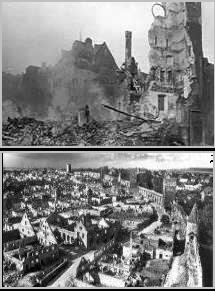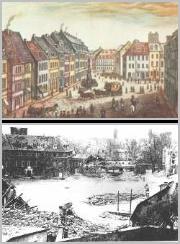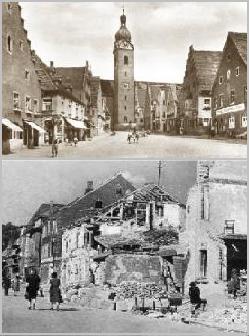

Potsdam is a former fishing village on the Havel River only 16 miles from Berlin, and it held more than 20 glorious palaces, 19 lakes, fountains and verdant parks. The small town dates from 993, but its real growth accelerated in 1713, under Friedrich and his father. Rococo palace Sans Souci, surrounded by terraced vineyards, stands majestically on a hill in the middle of a 725 acre park.
The HumboldtsIn April of 1945, Potsdam was horribly bombarded by 512 RAF bombers. 7,000 civilians died as a result of bombings, and most historic buildings and palaces were either gravely damaged, destroyed or extensively and joyfully looted by marauding troops. Even the bones of the great king were moved, and Potsdam was turned over to the communists as earlier agreed upon by the Allies.
On April 25, 1945, almost the entire city of Prenzlau was destroyed by American bombers. On the day before there were about 1,850 houses and two days later only 870 still stood. The population fell in the same period from 28, 500 to 15,700.
On April 18, 1944, Rathenow was attacked by U.S. bombers on their way to Berlin. Forced to turn around because of violent anti-aircraft fire, they dumped part of their lethal cargo on Rathenow. Between that and the destruction from Soviet troops, more than 75 percent of the city was destroyed.
On November 5, 1943, 374 USAAF bombers attacked the synthetic oil plant and marshalling yards near Recklinghausen. On the 19th another attack followed by 160 USAAF bombers. In the process, 12 churches and about 50% of the residential houses were destroyed.
Unlike the 190 other medieval German cities completely flattened by Allied bombing, many of Regensburg’s ancient buildings amazingly survived, including the famous cathedral. However, it was not for lack of trying. Regensburg suffered from 20 British bomb attacks and 8 American air assaults from 1943-1945. In 1943, an RAF attack killed 402 civilians. In total, 3,000 civilians here were killed by Allied bombing, including many prisoners of war. The Romanesque 9th century church of Obermünster was completely destroyed at the tail-end of the War by a violent, senseless bombing in March of 1945. Only the belfry still stood. The church could not be rebuilt.
On July 31, 1943, Remscheid-Lennep was almost completely destroyed during a British bombing which caused a horrible firestorm that killed 1,220 people. Today, a fifth of its inhabitants are foreign.
During World War II, the city became the target of several Allied bombing raids and there were three massive bomb attacks in Reutlingen 1945. It belonged to the ten most affected cities in the territory of present-day Baden-Wuerttemberg.
There are deep traces of the destruction, suffering and grief left behind from the war in Rositz even today. Although two major bomb attacks initially aimed at industrial targets in August 1944 and on February 14, 1945, many homes were also destroyed and 49 civilians killed.

Rostock evacuated 80,000 people during the war. Large parts of the historic city center city were destroyed by Allied bombing in 1942 and 1945. It was then sentenced to communist slavery for decades. Germans living on German soil that had been given to Poland were subjected to a policy of terror and/or deportation. Freed after reunification, only the western part remained part of Germany.

At the end of the second World War, there was a rush to destroy as many remaining towns as possible to insure the ground was cleared for “liberation” without any real struggles. March 31, 1945, the day before Easter, an Allied bombardment destroyed the east of the old town and 40% of the original city. But, who would know? Old Rathaus 1945, above.

War came early to the Saar, when 185 people were killed by bombing in July, 1942. Since then, the British and Americans both hammered the Saar. A heavy daylight attack of the American “flying fortresses,” supposedly aimed at the railway facilities, but of course just happened to hit residential areas and killed over 200 civilians. Twelve bomb attacks in three months would be the prelude to a series of another twelve attacks in three months, killing over 400 more civilians. While rubble of the last attack blocked the roads, another attack would commence, and the destruction grew larger and larger with each attack. In September of 1944, a new threat came from the air. Fighter bombers dive bombed the city, shooting at buildings and humans.
From October 5th, Britain’s “Butcher” Harris planned a solid double impact against the city: The first wave applied to the railway facilities, the second to the whole city. Old Saarbruecken went down, its residential areas foremost. A federation of 325 Lancaster bombers aimed at Saarbruecken in three waves, dumping approximately 2,500 high-explosive bombs as well as over 350,000 staff incendiary bombs in about a half hour. In the closely settled quarters of old Saarbruecken, the incendiary bombs released an enormous fire tower. Many Saarbrueckers who couldn’t reach shelters tried to survive the attack in their cellars, and hundreds died of suffocation or burned in their houses. 45,000 people became shelterless. Saarbruecken’s landscape was death and devastation. Authorities ordered the evacuation of the city. Even more attacks followed, and the British shifted to the use of sporadically released mines. When it was over, 1,334 more people were dead. After World War II, France again occupied the coveted Saar until 1957.
There were several violent Allied bomb attacks on the city.

Although Salzburg had cleverly escaped the ravages of the Thirty Years’ War and the Turkish invasion, Salzburg was bombed in World War Two as a cultural target. Allied bombing destroyed 7,600 houses and killed 550 inhabitants. A total of 15 strikes destroyed 46 percent of the city’s buildings, especially around Salzburg train station. The town’s historic bridges and the dome of the ancient cathedral were demolished when on October 14, 1944, 900 American bombers took the city by complete surprise and unloaded more than 9,000 high-explosive bombs on the historic city center, aiming for the cathedral dome and causing its collapse. Bombs falling on Salzburg, above.

In a 15-minute bomb attack on April 17, 1945 by Canadian and British bombers, 1,250 civilians were killed, the railway station and immediate area were fully destroyed as well as two large residential districts including historic Kreuzberg. Around 1,000 buildings, including 862 houses, were lost and 75% of the city was totally or partially lost, requiring ten years of reconstruction. A Baroque pilgrimage Catholic church and convent, Our Lady of Kreuzberg, which had stood since the 1600s, was among the victims and almost completely destroyed. It contained an alter by Lucas Cranach. Schwandorf became home to many displaced expellees from the Sudetenland.

On February 23, 1945, 24 “Liberator” bombers hit an air base near Schwäbisch Hall. American air raids aimed for the town center, and on February 25, 1945 nearly destroyed it. 53 civilians died. Again, on April 17, 1945, at the very tail-end of the war, the age old Rathaus was hit with incendiary bombs, leaving it a smoking rubble.